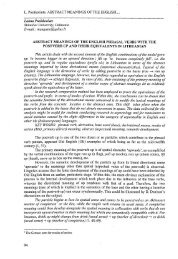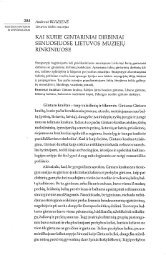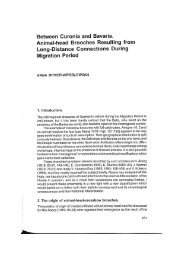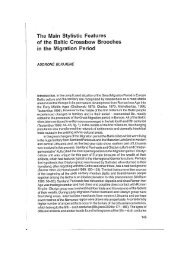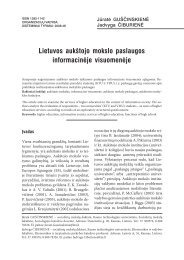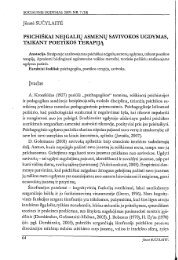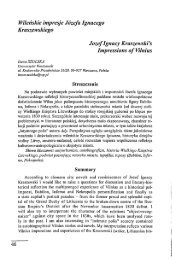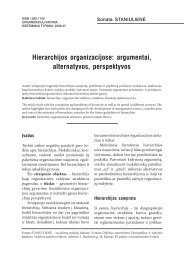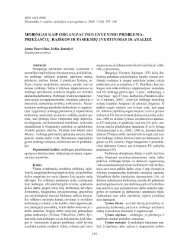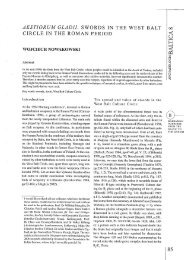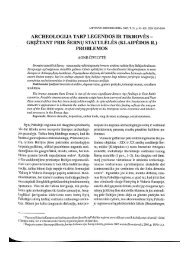ECO-MARKETING AND ECO-LABELLING: DOES IT ENSURE ...
ECO-MARKETING AND ECO-LABELLING: DOES IT ENSURE ...
ECO-MARKETING AND ECO-LABELLING: DOES IT ENSURE ...
You also want an ePaper? Increase the reach of your titles
YUMPU automatically turns print PDFs into web optimized ePapers that Google loves.
D.Grundey 171 ISSN 1648-4460<br />
Researching Customer loyalty in LHIiuania<br />
4. Analysis of Mini Case Studies in Eco-Marketing and Eco-Labelling: Germany and<br />
Lithuania<br />
4.1 The Impact of the "Blue AngeV'for Paints - a Mini Case Study<br />
One of the first Blue Angel product categories developed was for acrylic and 'highsolid'<br />
paints (these are the kinds of paint used for woodwork and metalvvork). The product<br />
selection criteria for this category limited the proportion of volatile organic compounds<br />
(VOCs) to 10 percent for acrylic paints and 15 percent for high-solid paints. The first acrylic<br />
paint to display a Blue Angel was introduced by Glasiirit in 1982; in 1987 eco-labelled paints<br />
represented approximately 16 percent of the total market for solvent-based paints in (West)<br />
Germany (ENDS, 1989); and by 1995 this figure had risen to just under 25 percent (telephone<br />
interview with Jerry Hodge, director, ICI paints).<br />
In 1990, the German government claimed that the Blue Angel for paints had reduced<br />
VOC emissions by 40,000 tons (OECD, 1991, p. 30). However, the environmental benefits<br />
resulfing from this reducfion should be viewed in light of the following.<br />
First, any benefit (private or public) which has arisen from the shift towards low-VOC<br />
paints did not come without a cost. The paints which have a Blue Angel are more expensive to<br />
produce, which implies that scarce resources have been utilised in the producfion of these<br />
paints that might have been utilized more efficiently elsewhere.<br />
Second, an alternative set of eco-label criteria might have had a similar impact at a<br />
lower cost.<br />
Third, it is possible that low-VOC paints would have come onto the market even<br />
without the eco-label. (Such paints might, for example, have been adverfised simply as 'lowsolvent',<br />
with the puфorted health benefits, rather than the environmental benefits, given<br />
emphasis.)<br />
Fourth, according to a report on eco-labels carried out by Environmental Data<br />
Services (ENDS, 1989, p. 23), 'Acrylic paints which carry the Blue Angel do not perform as<br />
well as more traditional products.' Indeed, the report ascribes the poor sales of eco-labelled<br />
paint in the professional market to this poor performance, noting that 'what counts for the<br />
professional decorator are aspects of product quality such as ease of application, colour and<br />
durability, and "environment-friendliness" ranks low on this Hst of purchasing criteria.' Poor<br />
performance may also lead to a need for more coatings, hence more overall consumption to<br />
accomplish a given task. More use per task may undo any puфortcd environmental benefits<br />
measured on a product weight or volume basis.<br />
Fifth, since no cco-labcl was applied to emulsion paints (which arc by far the largest<br />
sector of the paint market), it is possible that some consumers bought cco-labclled acrylic<br />
paints for use on walls and ceilings because they thought that such paints would have a lower<br />
environmental impact. In fact, emulsion paints typically have much lower concentrations of<br />
VOCs than even the ceo-labcllcd acrylic paints, so such purchasing habits would have been<br />
perverse indeed (ENDS 202, November 1989, p. 26).<br />
Finally, it is possible that some of the demand for low-solvent paint was the result of<br />
concern over the direct health impacts (rafiicr than the environmental impacts) of solventbased<br />
paints. Clcady, any reduction in emissions of VOCs which resulted from the use of<br />
low-VOC paint purchased primarily for its perceived health benefits should not be counted as<br />
a consequence of the cco-labcl, but rather as a byproduct of health-conscious paint purchases.<br />
rWlN.mniMATlOKS IN nVSIMiSS a-liCONOMICS, \'o\. 8, No 1 (16), 2009



